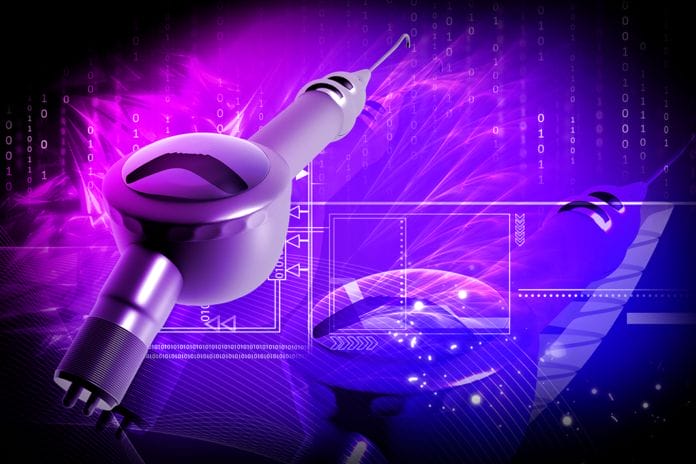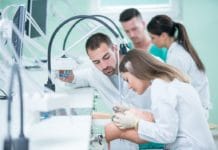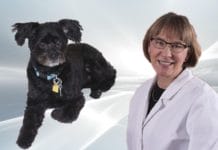Long gone are the days of messy, salty air abrasion polishing for stain removal on our patients. Welcome to a whole new world of safer softer powders and Guided Biofilm Therapy.
In 2004, a coworker RDH of mine told me about a new subgingival air polishing powder she had recently seen presented at a Perio CE in Vienna. I was extremely skeptical, so our team of hygienists and our periodontist gathered scientific articles and read and discussed the evidence (1-3). We were still somewhat mystified about this, remembering that traditional sodium bicarbonate powders were damaging to root surfaces and soft tissues4. The research showed that the glycine powder was safe for biofilm management on root surfaces and implants5. The research showed glycine air abrasion powder could be sprayed subgingivally, whereas traditional powders caused soft tissue damage.
To learn more, the office I worked for invited Dr. Greger Petersilke to an in-office biofilm management course with hands-on practice. We borrowed air polishers from the industry to try on willing patients. What a mess! The finer powder blew everywhere as the traditional air polishers were not calibrated for the finer glycine powder at 25mu, but we did see promise with the powder.
We eventually purchased an air polisher designed for the glycine powder. This made quite a difference. We started out just on implant patients and those with staining on the exposed root surfaces. Eventually, we were all noticing a difference in our patient’s gingival health. In our clinical experience, the tissues were pinker, tighter, and nonbleeding pocket depths were also reduced. We also noticed that patients had less and less staining, as the glycine was polishing the root surfaces, leaving less surface abrasion for new stain to form.
The advantage of air polishing over traditional rubber cup polishing is that the spray can be directed into the tissue and reach areas that were not reachable with a prophy angle. As you work with the air polisher and glycine powder, the sulcus opens up, and you can see into the sulcus/pocket area. Implants and mucositis are not always easy to manage the biofilm, however using the glycine powder, I know I am getting around that implant and into the sulcus/pocket area6.
In 2009, the EuroPerio 6 was held in Stockholm, Sweden; this changed my life and my patient’s treatment.
Introduced at the conference was a new subgingival tip/nozzle for depths up to 10mm (6mm in the US). EuroPerio7 was held in Vienna, Austria, and a consensus report came out, reviewing all the current research on the newer air abrasion powders7. Imagine a 25mu powder changing how I looked at periodontal and implant treatment and biofilm management. We started seeing all surgery patients two weeks prior to surgery for biofilm management, using the nozzle in the pocket and air polishing the whole mouth. We saw great results postoperatively.
The glycine powder at 25mu is so much finer than the traditional powders at greater than 64mu. I personally love that I can go subgingival and see in the pocket knowing I am giving the optimal care to my patients. Life for this RDH was good. Then BAM! A new powder came on the European market in 2013; a finer smaller particle powder made with erythritol powder at 14mu8. Again, as with most new products, I need to see the evidence and then see for myself clinically, so, I was a bit skeptical at the beginning. My patients noticed the difference right away, however. They noticed the finer sweeter tasting powder. As with most products, you really need to have the newer air polishing unit that is calibrated for finer powder, since older models are just not as calibrated for the finer, smaller particles.
The new powder brought new evidence and a new method of thinking for your hygiene appointment: Guided Biofilm Therapy (GBT)9. GBT is a dental biofilm management protocol “based on the clinically proven technologies invented by EMS. It was developed in cooperation with highly respected and experienced periodontologists, cardiologists and dental hygienists.9” The concept of Guided Biofilm Therapy is removing stain and soft deposits before scaling. The patient is disclosed (we find that disclosing is one of the best teaching tools we have for ourselves and our patients), then we use the glycine or erythritol powder to “polish” the teeth. Using disclosing solution, a clinician can get a really good idea of how long it takes for complete removal of biofilm.
Once the biofilm management is complete, scaling with ultrasonics and hand instruments is completed. If needed, you can follow up with another go of the air abrasion polishing. I personally clean the dorsal of the tongue at the end, just for complete biofilm removal. For this, I either use the air polisher or polish with a handpiece and a soft occlusal brush or a disposable tongue scraper attached to the suction. We apply either fluoride or chlorhexidine varnish as needed. At first, patients thought I wasn’t going to scale their teeth, but with an explanation of the new order of care and upon completion of treatment, patients have gotten used to this new method.
GBT might seem backward for many, as it does go against some of what we learned in school, but remember, we sometimes have to think outside of the box. I had already started polishing first a few years ago, so this idea was not hard for me to grasp, and did seem to make sense. Removal of the soft deposits and stain removal first makes for less scaling (hand/power) overall possible.
In the course of our treatment, we will often tighten the interval of hygiene appointments to sometimes six weeks for peri-implant cases. It’s a shorter appointment also, as we are just focusing on biofilm disruption.
My ortho cases also love it. I can adapt the spray to above and below the brackets, and really get interproximally, without tissue damage or tons of bleeding. I have an orthodontist as a patient, and she loved this system so much she bought one for her practice. She now does a quick “polish” as she is changing wires or placing brackets or bands.
Patients love the feeling of a super clean mouth; this also motivates the patient to keep their mouths cleaner. I no longer polish with a traditional rubber cup prophy angle, I prefer to say I biofilm manage! The changes I have seen in my almost 30 years of working in hygiene, the development of the finer glycine and erythritol powders have to be the largest improvement.
SEE ALSO: Getting Down to It: Gingival Recession & the Sensitivity It Causes
REFERENCES
- https://www.ncbi.nlm.nih.gov/pubmed/12702105
- https://www.ncbi.nlm.nih.gov/pubmed/12710749
- https://www.ncbi.nlm.nih.gov/pubmed/12694431
- https://www.ncbi.nlm.nih.gov/pubmed/25727403
- https://www.ncbi.nlm.nih.gov/pubmed/25690301
- https://www.ncbi.nlm.nih.gov/pubmed/26362615
- https://www.ncbi.nlm.nih.gov/pubmed/23616981
- https://www.ncbi.nlm.nih.gov/pubmed/28390211
- https://www.ems-dental.com/en/guided-biofilm-therapy











